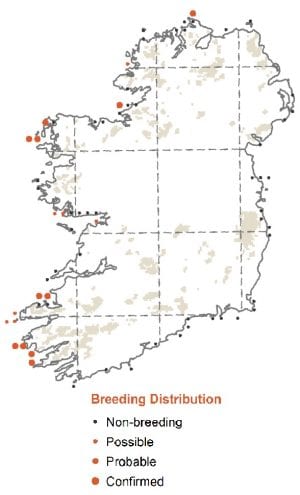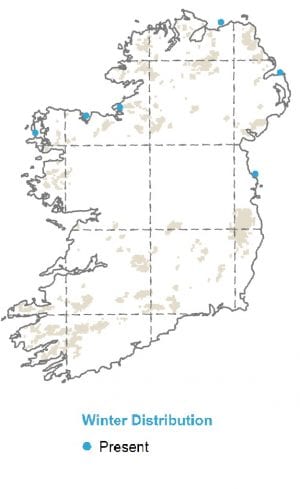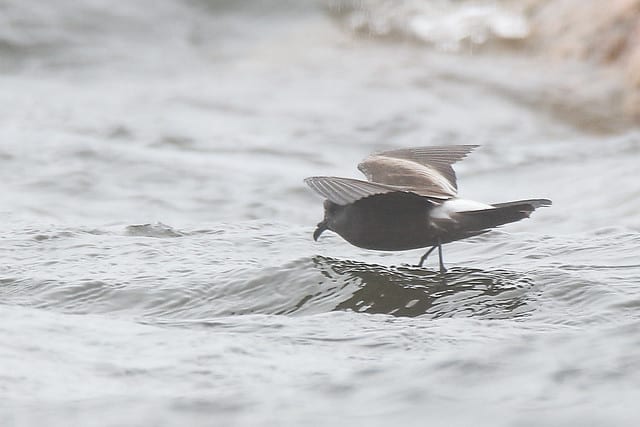
Storm Petrel
| Irish Name: | Guairdeall |
| Scientific name: | Hydrobates pelagicus |
| Bird Family: | Tubenoses |
amber
Conservation status
Conservation status
Status
Summer visitor to all coasts from April to August.
Identification
A small, dark seabird with a white rump, recalling a House Martin. Small in size with short wings, a quick flight action, sometimes dangles legs over the sea when feeding. Straight bill with hooked tip and tube-shaped nostrils on the upper mandible, giving distinctive bill shape if seen at close range. Nostrils used to excrete salt. The smallest of the petrels found in Irish waters and only likely confusion is with the scarcer Leach's Storm-petrel (the Wilson's petrel is very rare). Small size, square shaped rump patch extending down onto the sides and quicker flight action aid separation. Diagnostic broad, whitish band on underwing. Square shaped tail.
Voice
A chattering call. Usually silent at sea.
Diet
Taken from the sea. Small fish, plankton, molluscs and crustaceans.
Breeding
Breeds in colonies on islands off the west coast. Found from Co. Cork to Co. Donegal. A difficult species to survey as it only returns to its nest site after dark which is concealed under vegetation, in boulder fields and in old buildings and walls. The great bulk of the population is found in Co. Kerry with the Skelligs and the Blaskets having huge colonies. The largest colony surveyed in the world to date is on a Inishtooskert, in the Blaskets, a small uninhabited island easily visible from the mainland.
Wintering
Pelagic, winters at sea in the South Atlantic.
Monitored by
Breeding seabirds are monitored through breeding seabird surveys carried out every 15-20 years.
Blog posts about this bird

BirdWatch Ireland Nature Reserves to form part of Ireland’s first Marine National Park
BirdWatch Ireland is proud to partner with the National Parks and Wildlife Service (NPWS) and others in managing Ireland’s first Marine National Park – Páirc Náisiúnta na Mara, Ciarraí.
Announced on World Earth Day on Monday, April 22nd, the new National Park in Corca Dhuibhne, Co Kerry will unite some of Europe’s most ecologically valuable places across 70,000 acres of land and sea. These lands and waters provide extremely important nesting sites and food sources for seabirds including Red-listed species such as Puffin and Kittiwake and many other vulnerable Amber-listed species such as Manx Shearwater, Gannet and European Storm Petrel.
The Park will incorporate internationally important sites for seabirds such as BirdWatch Ireland managed Little Skellig and Puffin Island, as well as An Tiaracht Nature Reserve, which is managed by the Commissioners of Irish Lights.
It will also include new acquisitions by the National Parks and Wildlife Service (NPWS), such as the Conor Pass, the Owenmore River catchment, lands at Mount Brandon and the sand dune system at Inch Peninsula, along with sites already under State ownership, including the limestone reefs of Kerry Head Shoals and the waters around the Blasket Islands. The Páirc’s heritage legacy would be further enhanced by the inclusion of lands on the Great Blasket Island, the globally significant UNESCO World Heritage property of Sceilg Mhichíl, and Derrynane House, Historic Park and Beach, which are managed by the Office of Public Works (OPW).



Kittiwake. Photo: John Fox.
Páirc Náisiúnta na Mara, Ciarraí was officially launched in Dingle on World Earth Day, with Jill Crosher from BirdWatch Ireland’s Corca Dhuibhne (West Kerry Gaeltacht) Branch serving as a proud local representative of BirdWatch Ireland at the event. In light of the announcement, CEO of BirdWatch Ireland Linda Lennon said: “We are delighted to announce our partnership on the new Páirc Náisiúnta na Mara, Ciarraí. This area, including BirdWatch Ireland’s Puffin Island and Little Skellig Nature Reserves, provides vital breeding and feeding sites to some of our most iconic and endangered seabirds. At BirdWatch Ireland, we are strong believers in the power of collaboration when it comes to making real change for our birds and wider biodiversity. We look forward to embarking on this new journey with our partners the NPWS, the OPW and the Commissioners of Irish Lights.” Speaking at the launch, Minister of State for Nature, Heritage and Electoral Reform, Malcolm Noonan said: “With the iconic Conor Pass as the gateway, Ireland’s first Marine National Park brings mountains, blanket bog, heaths, rivers, coastal dunes, limestone reefs, sea cliffs and some of the wildest land and seascapes in the country together in celebration of nature. Alongside its seven sister parks, Páírc Náisiúnta na Mara, Ciarraí will be a flagship for the protection and restoration of these incredible places and the globally important array of wildlife that they are home to. The Páirc will also honour the island and coastal communities who live alongside it by ensuring that their unique tapestry of cultural and natural heritage is central to the future story of this special place.” Niall Ó Donnchú, Director General of the National Parks and Wildlife Service said: “Our new park is a celebration of heritage in all its forms. Our biodiversity and natural heritage sit layered in harmony alongside monuments and historic wrecks from many periods. This is a place of iconic significance and majestic beauty. At times, shrouded in mist as a far outpost, ethereal in its past, evocative in its firing of the imagination, and vital in its biodiversity. Undoubtedly, a place of local pride and universal value. We look forward to working with our partners, the Office of Public Works, the National Monuments Service, the Commissioners for Irish Lights, Birdwatch Ireland, Kerry County Council and the local communities to realise a truly world-class National Park.”
Gannet. Photo: Gerry Kerr.
Established in 1983, Puffin Island Nature Reserve off the southwest tip of Kerry is a summer home to many cliff- and burrow-nesting birds. As its name suggests, the island hosts many Puffins, with thousands of pairs of this Red-listed Bird of Conservation Concern nesting there every summer. The island also holds one of the largest colonies of Manx Shearwater in the country, with large numbers of Storm Petrel also breeding here. Fulmar, Guillemot and Razorbill are some of the many other species for which this site is important. Owned and managed by BirdWatch Ireland, Puffin Island Nature Reserve is already a Special Area of Protection (SPA) under the European Birds Directive and an Important Bird Area (IBA) as identified by BirdLife International. The inclusion of the reserve in Páirc Náisiúnta na Mara adds another layer of protection to this vitally important site for birds. The Little Skellig Nature Reserve is an iconic BirdWatch Ireland nature reserve famed for its colony of some 35,000 pairs of Gannets – the largest breeding colony in Ireland and among the largest in the world. There are also smaller numbers of Guillemot, Puffin and Kittiwake present. Both Little Skellig and the adjacent Skellig Michael are protected by a Special Protection Area, designated under the European Union Birds Directive. These islands also form one of Ireland’s Important Bird Areas. While seabirds are highly dependent on Puffin Island and Little Skellig in order to breed, they also rely on the surrounding seas as a food source so it is vitally important that they receive protection. The announcement of Páirc Náisiúnta na Mara, Ciarraí is a step forward for seabirds, and the many other species that share these habitats with them.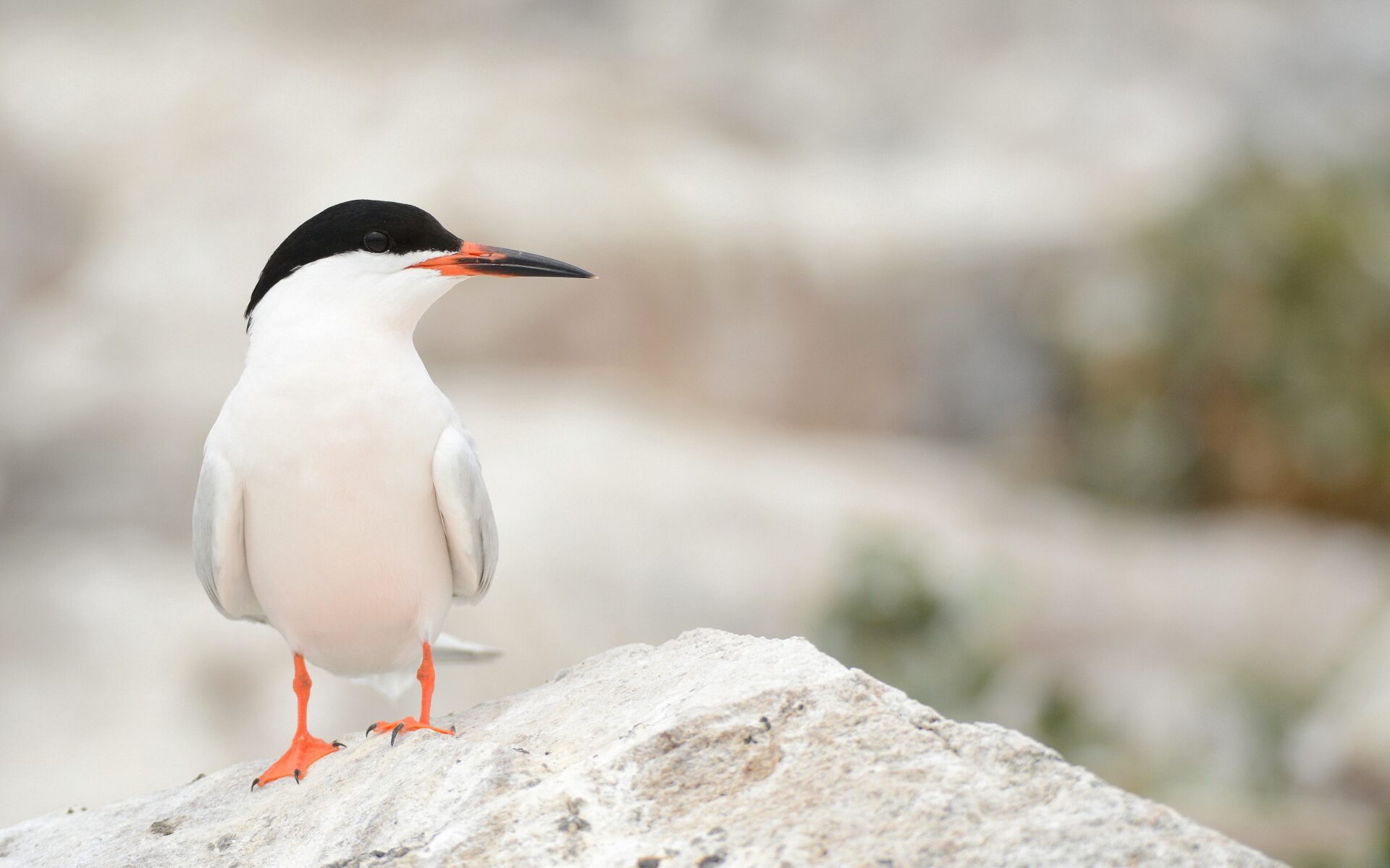
Seabird Census shines light on plight of seabird populations in Ireland and Britain
A newly-published seabird census highlights how conservation management measures can boost tern populations, while also revealing concerning declines in Puffin and Kittiwake populations in Ireland.
Seabirds Count, released as a book by wildlife publishers Lynx Edicions, is the most comprehensive seabird census produced to date, providing population estimates for the regularly breeding species of Britain, Ireland, Isle of Man and the Channel Islands.
The census, which ran from 2015 to 2021, covered all of our regularly breeding seabird species, including nocturnal burrow-nesters such as Manx Shearwater, inland and urban-nesting gulls and several rare species. Led by the Joint Nature Conservation Committee (UK) with over 20 steering group partners, including BirdWatch Ireland and the National Parks and Wildlife Service, who spearheaded efforts to collect and publish the findings in Ireland.
The census results underscore the benefits of focused conservation management work, while also revealing some concerns. Results differ significantly by region or country. However, overall results show that, across the entire UK and Ireland, 11 of the 21 seabird species with comparable data have declined since the last census in 1998-2002.
In Ireland, 17 species have seen population increases, while two – Puffin and Black-legged Kittiwake – have experienced declines.


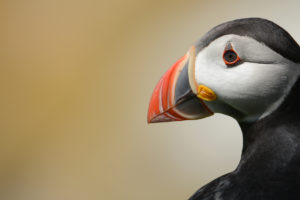
Puffin. Photo: Brian Burke
Puffins are reliant on sandeels and this crucial food source is in decline in waters off Britain and probably Ireland. This is one of the many potential factors contributing to the species' decline, though more research is needed to get a full picture of what is affecting this iconic bird. The Puffin has declined by 28% in Ireland and is now a Red-listed bird of conservation concern, meaning it is vulnerable to extinction. The Black-legged Kittiwake has declined by 36% in Ireland since the previous census. While Northern Ireland has seen a 33% increase in this species, overall, the species is on the decline. Numbers in the census show an overall decline of 42%, the lowest recorded in any census to date. The main reasons for its decline appear to be the reduction of sandeel availability due to climate change, local predation and extreme weather events. There are encouraging trends in Ireland for species such as terns. This underscores the importance of our tern wardening work with NPWS at key east coast colonies such as Rockabill, Kilcoole and Lady’s Island Lake. However, while the Arctic Tern population is stable in Ireland, at the overall census level, there has been a 35% decline in the Arctic Tern breeding population since the previous survey. Across Britain and Ireland, the census shows that Ireland is particularly important for species such as Roseate Tern as 94% of the total populations breed here.
Roseate Tern. Photo: Brian Burke.
The Roseate Tern populations at Rockabill and Lady’s Island Lake have benefitted from a range of conservation efforts via ongoing NPWS wardening projects, delivered by BirdWatch Ireland. Driven to the brink of extinction due to the use of their feathers for the hat trade during the 19th century, the Roseate Tern population recovered through protective legislation and management. Rockabill holds the vast majority of the northwest European breeding population and, thanks to the ongoing conservation management, numbers have increased by 155% since the last census. However, the Roseate Tern remains one of our rarest seabirds, with an estimated 2,000 pairs confined to a few colonies around these islands, and in 2023 both the Rockabill and Lady’s Island Lake tern colonies were impacted by a Highly Pathogenic Avian Influenza (HPAI) outbreak. An increase in testing, the quicker removal of carcasses after they have been reported and more collaborative action and joined-up thinking between all relevant stakeholders are required if we wish to stem potential devastating effects of avian flu on seabird populations. Ireland is also of importance for European Storm-petrels, with 73% of the census population breeding here. The majority of the European Storm Petrels in Ireland breed in large colonies located off the southwest coast. Numbers from the census appear to show a stable population. Meanwhile, the Black-headed Gull has seen an increase of 84% in Ireland, which is in contrast with overall census-level decline of 26%. While there are certainly reasons for hope, it is clear, to halt and reverse the overall decline in our seabird populations, much more needs to be done to protect these birds and their breeding and foraging areas from the multitude of threats they face.




